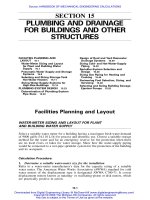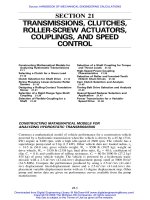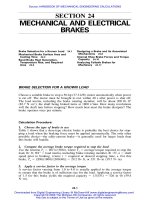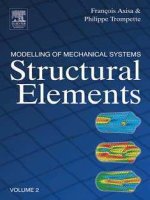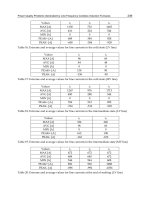Illustrated Sourcebook of Mechanical Components Part 14 docx
Bạn đang xem bản rút gọn của tài liệu. Xem và tải ngay bản đầy đủ của tài liệu tại đây (4.13 MB, 57 trang )
Creative Assemblies
27-
11
,
Diuphragms
.
Piston
Double-acting actuator provides for
thrust in either direction by placing
two diaphragm assemblies back to back.
Diap
n
raynm
Regulating valve controls the value
ot
air
pressure by means
of
a
diaphragm-bal-
4
anced valve and
two
control diaphragms.
Diaphragm
'
u+-
I
Shaft
Shaft seal
uses
lubricant pressure to
force the sidewall of the diaphragm to
8
roll
against the shaft and housing.
Double-acting pump has
two
diaphragms
to give smooth and continuous flow
of
fluid
5
to equipment
at
a
safe working pressure.
Damping mechanism prevents abrupt
or
sudden
motion
in a machine. Damping
9
amount
is
controlled by orifice size.
27-
12
Control-Locked
Thwart
Vibration and Shock
Critical adjustments stay put-safe against accidental turning
or deliberate fiddling with them.
Frank
William
Wood
JR.
w
Clamp
knob
a SPLIT YOKE
clamps
on
shaft when
eccentric squeezes ends of yoke together.
Knurled knob is handy for constant use, and
eliminates need
for
tool. Another advantage
is
high torque capacity. But this design needs
considerable space
on
panel.
2
FINGER
springs
into place between gear
te
h
at
turn
of
cam. Although gear lock
is
ideally suited for right-angle drives,
size
of teeth limits positioning accuracy.
Knurled
Split
I
3,.
SPLIT
BUSHING
tightens
on
control
shaft, because knurled knob has tapered
thread. Bushing also mounts control to
panel,
so
requires just one hole. Lever, like
knob, does away with tools, but locks tighter
and faster.
For
controls adjusted infre-
quently, hex nut turns
a
fault into an ad-
vantage. Although it
takes
a
wrench to turn
the nut, added difficulty guards against knob-
twisters.
'
Control
shaft
Hex
nut-'
4
CONSTANT
DRAG
of
tapered collar on
shaft makes control stiff,
so
it doesn’t need
locking and unlocking. Compressed lip both
seals out dust and keeps molded locking nut
from rotating.
Creative
Assemblies
27-13
5.
.
TONGUE
slides in groove, clamps
down
on edge
of
dial.
If
clamp is not tight,
it
can
scratch the face.
6,.
SPOT-BRAKE
clamp
is
self-locking, which
means it takes two hands
to
make
an
adjustment,
one
to
hold the clamp open
and one to
turn
the dial.
27-
14
Li
uid level Mechanisms
-
In
3
icators and Controllers
Means
of
determining liquid level,
detection
of
changes in liquid level,
transmission
of
indicated levels.
or
warnings
of
changes heyond set limits;
and means
of
using level changes for
level control, or control
of
other con-
ditions such a5 temperature and pres-
sure, have been accomplished by numer-
ous
mechanisms. The most pcpular
&
-Ffoaf
chamber
devices employ floats or pressure meas-
urement with instruments such
as
the
U-tube manameter, bourdon tube, and
bellows.
The methods shown here are largely
indicating methods or simple devices for
automatic control
of
liquid level al-
though they can conceivably be applied
to control other conditions such as tem-
perature and pressure. Methods using
electric resistance
of
a column
of
liquid
and measurement
of
pressure changes
by means of piezo-electric crystals are
not shown. Patent
No.
2,162,180
de-
scribes
a
method involving determina-
tion
of
change in air pressure when
a
measured volume
nf
air
is
introduced
into
a
tank.
Fig.
1
-Float and Lever- Operated
Pilot
Valve
Sfof
for
fioat
counterweigh
f
ann
Sfop
for
f/oaf
,
1
movemen
f '
fed
or
dece/erated
movements ofplunger
for
any
floaf
movemen
U
Fig.2-Float
and
Cam-
Operated
Pilot
Valve
Bourdon
tube
sqpporfs
magnefic
core
in
re-
sista7ce
coils
~
i
Y
(Magnefic
core
flfi
v
v
_
:
i
tmavbe~ud-
/ndicafor
or
recorder
-
I
F/ouf ,
IM
II
<i r
pokted
C;i;-'o
by
float
in
mercury
I/
-
tube)
4ire
connecfion
fo
gafvano-
meter
in
receiver
Fig.4-Float and
Pulley
Indicator
Fig.5-Pressure
Dome
Indicator-
Creative
Assemblies
27-
1
5
Sec+/ona/
view excepf
for
weigbfs
and
ffoaf
Fig.
6-Float
Control
of
Discharge
Tape visible
Vapor-
figh
f
covers
/
through
window
Tank
floor,
At-Pu//ey
frome
supporf
Fig.
8-Tank
Roof
Indicator
.
I
_-__
-
Fig.7-U-Tube Manometer
with
Water
Columns
Double bdancing mechanism
fUfs
mercury
swifcbes
for
u/arms
when
refri
eranf
is
be/ow eifher
operufing
or
idle
&e/s
-
-Groo
ves
: F/oafing
frigerun
f
sdmpling
reservoir
Fig.10
-Refrigerant Balance
Back
Front
Fig.9-Dip
Stick
I
ndica
tor
liquid
>eve/
5.50
indicufed
b
y
/tgh
f
reflecffon
from
menrsrus
Fig.11
-Automatic
Battery Filler
27-
16
Liquid Level Indicators and
Controllers
Thirteen different systems of operation are shown. Each one represents at least one
commercial instrument. Some of them are available in several modified forms.
Iml
The Bristol
Co.
Bubbler fixture
&Air
supply
Either method can
DXAPHRAQM ACTUATED INDICATOR.
Can be used
with
BUBBLER TYPE RECORDER
measures height
E.
can
any kind
of
liquid, whether it be flowing, turbulent, or be used with
a11
kinds
of
liquids, including those
carry-
carrying solid matter. Recorder can be mounted above
or
ing solids. Small amount
of
air is bled into submerged
belnw the level
of
the tank or reservoir.
pipe. Gage measures pressure
of
air
that displaces fluid.
BELLOWS ACTUATED INDICATOR.
Two
bellows
and
connecting tubing are fllled with incompressible fluid. Change
in liquid level 'displaces transmitting bellows and pointer.
I
I
i
L/,51
Use
terminol5
forpumpdown,
terminal
3
for ourno-uo
control
f
ELECTRICAL TYPE LEVEL CONTROLLER.
Positions
of
probes determine duration
of
pump operation. When
liquid touches upper probe, relay operates and puinp
stops. Through auxiliary contacts, lower pmbe
Pro-
vides relay holding cdrrent until liquid drops below It.
op-ociing
switch
To
float
in
ion&
Minneapolis
-
Honeywell
FLOAT-SWITCH TYPE CONTROL-
LEX.
When liquid reaches predeter-
mined level, float actuates switch
through horseshoe-shape arm. Switch
can operate valve
or
pump,
as
required.
c,
/
-
-
___
AUTOMOTIVE TYPE
LIQUID
LEVEL INDICATOR.
Indicator and tank
Unit
are
connected by
a
single wire.
As
liquid level in tank increases, brush contact on
tank rheostat moves
to
the rlght, introducing
an
increasing amount
of
resistance
into circuit that grounds the
"F"
coil. Displacement
of
needle from empty
mark
Is
proportional
to
the amount
of
resistance introduced into this circuit.
Creative
Assemblies
27-1 7
Recorder
Counterweigh
f
'rope
yoot
float
chamber
Minmaplis
Mneywell
FLOAT TYPE RECORDER. MAGNETIC LIQUID LEVEL CONTROLLER. DIFFERENTIAL PRESSURE SYSTEM.
Pointer can
be
attwhed to
a
When liquid level
is
normal, common-to-right Applicable to liquids under pressure.
calibrated float tape to give
Measuring element is mercury manometer.
an approximate hstantane-
level
drops
to
predetermined
level.
magnetic Mechanical
or
electric meter body can be
ous
indication
of
fluld level. Piston
is
drawn below
the
magnetic field.
used. Seal
pots
protect meter body.
leg circuit of mercury switch is closed. When
t
of
ocfuofing, Pressure gouge
e
r-7
element
,
-_
PA
Seof required
fw
corrosive
or
viscous
fluiUs
Mimqoofis-
HmRywrll
DIRECT READING FLOAT TYPE GAGE.
Inexpensive,
direct-reading gage has dial calibruted to tank volume.
Comparable type
as
far
as
simplicity
Is
concerned has
needle connected through
a
right-angle arm to
float.
As
liquid level drops, float rotates
the
arm and the needle.
PRESSURE UAUE INDICATOR
for
open vessels.
Pressure
of
liquid head
is
imposed directly upon actuating element
of
pressure gage. Center line
of
the
actuating element must
conincide wlth
the
minimum level line
if
the gage
is
to read
zero when
the
liquid
reaches
the
minlhum level.
Heoter
wire-
Bimetal
strip
-
-
7,
BIMETALLIC
TYPE INDICATOR.
When tank
is
empty, contacts in tank unit
just touch. With switch closed, heaters cause both bimetallic strips to bend.
This
opens contacts in tank and bimetals cool, closing circuit again. Cycle repeats about
once per sea
As
Hqutd level increases. float
forces
cam
to
bend tank bimetal. Action
is
simllar to previous case, but current and needle displacement are increased.
rank
-Float
SWITCH ACTUATED LEVEL
CON-
TROLLER.
Pump
is
actuated by
switch. Float pivots magnet
40
that
upper pole attracts switch contact.
Tank wall
serves
as
other contact.
27-18
Hangers
Put
Up
by
Hand
No
tools needed to install these hangers made
of
wire, rod or bar-stock.
L.
Kasper
CLIP
is most secure when tubing
of
right size
helps keep it spread.
To
install, hook one side
over edge
of
slot and spring in other side.
EDGE HANGER
doesn’t have to be sprung,
but requires enough clearance above holes
so
that ends can be pushed down through.
RAMPS
cam split end together
as
hanger
is
pushed into slot. Ends spread again when
notches engage sheet.
Small
end enters large slot first, then tilts over
into smaller, close-fitting slot.
Creative Assemblies
27-
19
LOOP
hooks over bar and
is
held secure by
short tail which snaps into hole drilled
through the side.
COIL
grips edges
of
T-
or I-section
or
flat
bar. Spreading the ends wraps wire tightly
around tubing to prevent vibration.
DOUBLE HANGER
supports two
tubes
8s
they pass through divider. While tubes are in
place hanger can’t
come
out.
8
END PIECE
supports pipe between
waUs
of
any thickness. First spring it over pipe, then
slide it along pipe into holes.
27-20
Assemble
Sheetmetal with
Sheetmetal
These sheetmetal parts join sheetmetal quickly with the simplest
of
tools.
L.
Kasper
SQUEEZE
CLIP
holds two overlapping
sheets together. The ends of the clip are
pushed through parallel
slots,
then bent
over much
like
a
staple.
ALIGNING
PIECE
slides up out of the
way in long slot while butting sheets
are
being positioned. Afterwards it slips down
over
lower
sheet.
CUP
carries
a
bar
on
both sides
of
divider.
Here bars stick
up
above
the
top,
but
deeper cutout
will
lower them until they
are flush
or
sunk.
ESS
supports shelf between uprights,
By
mating with notched edge it acts as a key
to
keep shelf from sliding back
and
forth.
and
provides
positive
location,
Creative Assemblies
27-2
1
Devices
for
Indexing
or
Holding
Mechanical Movements
Louis
Dodger
v
detent
/
AXIAL POSITIONING
(INDEXINS)
BY
MEANS
OF
SPACED
HOLES
IN
INDEX
BASE
!l.
ROLLER
DETENT
POSITIONS
IN
A
NOTCH:
Ntana
1
-cos
RISE,
S
z=
-
-
2
COS
a
ROLLER RADIUS,
R
=
(ivy,
.)(
COSa
)
1
-cOSa
\
Re
foihihg
Puf/
hob
Din
to
release
RADIALLY ARRANGED DETENT HOLDS
IN
SLOTTED INDEX BASE
27-22
Slashes
Errors
with
Sensitive Balance
SENSITIVITY
OF
BALANCE
is
independent
of
temperature fluctua-
tions.
To
keep the center
of
gravity
constant, two temperature-sensitive
elements are riveted to aluminum-
alloy balance beam, bridging
a
slot
which
is
directly over the balance
point. Their coefficient
of
expansion
compensates
for
beam deflection
caused
by
variations in temperature.
Enclosed in a cylindrical canister
at the rear
of
the balance beam is
a
vane that damps its movement, pre-
venting oscillation. The hanger at
the front
of
the scale carries sets
of
ring weights which are lifted by cam-
operated levers. The shafts on which
the cams are mounted are connected
to the mechanical readout.
The scale in effect weighs
by
sub-
traction since it is balanced, when
empty, by all the ring weights resting
on
the hanger.
To
weigh
an
unknown,
the ring weights are lifted from the
hanger. The
sum
of
the raised weights
is
shown
on
the mechanical counter,
which displays the
first
three digits.
The complete total
is
displayed by the
mechanical plus the optical system
that projects through the reticle.
Creative Assemblies
27-23
Rotary
Piston
Engine
Warren Ogren, Inventor
Robert Parrnley, Draftsman
Exploded drawing of engine
illustrates the many standard
mechanical components that
are arranged to preform a
function in a new way.
27-24
End View
of
Rotary Piston Engi
Figure
2
1
25
\i
.’
FIG.
3
1
I
7
cu
9
>
t-Away View
of
Rotary Piston Engine
42
Figure
3
41
ILLUSTRATED
SOURCEBOOK
of
MECHANICAL COMPONENTS
SECTION
28
DESIGN
Volume and CG Equations 28-2
Common Area of Intersecting Circles 28-10
Compound Angles 28-12
Calculation of Dihedral Angles
28-
15
Frustums of Cones
28-
18
Length of Material for 90-Degree Bends 28-
19
8
Simple Methods to Measure Moment of Inertia 28-20
Friction Wheel Drives Designed for Maximum Torque
28-22
Radii of Gyration for Rotating Bodies
28-24
Design
Formulas
28-3
or
OLUME
equations are included for ail cases. Where
V
the equation for the
CG
(center of gravity) is not
given, you can easily obtain it by looking up the volume
and CG equations for portions of the shape
and
then
combining values. For example, for the shape above,
use the equations for a cylinder, Fig
1,
and
a
truncated
cylinder, Fig
10
(subscripts
C
and
T,
respectively, in the
equations below). Hence taking moments
5.
.Quadrant
of
cylinder
6.
.Fillet
or
spandrel
R”L
=z=
0.2146R’L
R
=
0.2234R
10
-
37r
B=-
12
-
37r
In
the equations to follow, angle
B
can be either
in
degrees or in radians. Thus
B
(rad)
=
d/180
(deg)
=
0.01745
B
(deg).
For
example, if
0
=
30
deg in Case
3,
then sin
0
=
0.5
and
=
0.637R
2R
(0.5)
3
(30)
(0.01745)
B=
Symbols used are:
B
=
distance from CG to reference
plane,
V
=
volume,
D
and
d
=
diameter,
R
and
r
=
radius,
H
=
height,
L
=
length,-Nicholas
P.
Chironis
28-4
9.
.Sector
of
hollow cylinder
v
=
0.01745
(R?
-
eL
38.1972
(R:'
-
r:%)
sin
8
(R2
-
r'l)
8
Bi
=
0.3125L
B-
=
0.3750
~
V
=
D'L
=
0.3927D2L
I
11.
.Truncated cylinder
I
(with partial circle base)
b=R
(1
-cos@)
V=-
R:'L[
sin& sin:'
B
e
cos
01
b
3
5
sin
0
cos
6
8
+
1-2
+!]
sin:'
8
cos
0
8 cos
4
sin:'
8
3
[I
-
cos
01
[sin
0
-
-
-
~
2R[
6'
COS
0
+
sin
8
6'
+
sin
8cos
8
2 28
8
5
sin:'
0
6
sin:'
B
cos
0
12
where
N=
12.
.Oblique cylinder
(or
circular hole at oblique angle)
H
I/
=
'D2
-
=
0.7854D2H seC
6
d
B=H/2
r=-
2
4
cos
e
13.
.Bend
in
cylinder
4
3
60
V
=
-
D2R8
=
0.0274D2R8
BI
=
y
tan
%
B:!=ycotB
y
=
R
[
1
4-
-&I
14.
.Curved groove in cylinder
Design
Formulas
28-5
18.
.Slot through hollow cylinder
L2
1
T
4
19.
.Intersecting cylinder
(volume
of
junction
box)
20.
.Intersecting hollow cylinders
(volume
of
junction
box)
28-6
Design
Formulas
28-7
29.
.Shell
of
spherical sector
30.
.Shell
of
spherical segment
31.
.Circular hole through sphere
32.
.Circular hole through hollow sphere
~~
33.
.Spherical
zone
V=F(R
3
-
r7)
(sin
02
-
sin
Oi)
B=
0.375
(R4
-
1-4)
(sin
82
f
sin
61)
R3
-
$
RINGS
36.
.Hollow
torus
37.
.Bevel ring
28-8
Design
Formulas
28-9
Design
Formulas
28-
11
Let
r
=
2.0,
R
=
3.0,
c
=
1.75
,.
c
175
i
hen,
-
T
=
2.0
=
0.875
regions indicated
by
shaded and open
areas:
K’s
for coniinon areas of in-
teisecting circles fall within thc rec-
tangnlar, central portion. Points fall-
ing within upper left portion (outside
the rectangle) indicate the circles do
not intersect. Along the line,
K
=
1,
circles aie tangent;
points
in lower
right or left portions indicate one cir-
cle is completely within the other.
R3
r
2
_=_=
I’rom
the graph,
K
approximates
A,
=
(1
-
0.66)
B
(3)2
=
9.6
sq
in.
The graph is separated into
four
0.66
and
Design
Formulas
28-
13
Turn
5O
Tip
5"
Turn
5O
Tip
IO"
Turn
IOo
Turn
10"
Turn
5O
Tip
IO"
Tip
15'
Tip
15"
To
Find
Trne
Angle:
These
5
scales
show
the
most likely comhinationa
of
tipturn angles. In
each
combi-
nation
use
the black de
for
the case angle
A.
Example:
tip-turn
angles are
5O;
the
case
angle
is
29O.
On
shaded scale opposite
29",
read
that
20'
must
he
added
io
get
true angle
T
=
29O20'.
28-
14
Angle
'8'
Graphical
Solution
of
True
Angle
This chart
is
laid out
with
two
curves for tip-turn angle combi-
nations. Example: case angle
A
1
29",
tip and turn
angles
are
5".
Follow
construction lines to
see
that
20'
must
be
added
to
an-
gle
A
=
29",
to get true angle
T
=
29"20'.
Proof
Given
0,
a
and
@
To
Find
T
Solution:
AC
=
1
=
AB'
CB
=
tan
o
=
B'C
B'C'
=
sin
+
=
CD
B'C"
=
COS
a
(B'C
+
CE)
CE
=
tan
a
CD
B'C"
=
(tan
0
+
tan
a
sin
9)
X
COS
a
=
tan
B
cos
a
+
*
X
cos
a
cos
u
sin
+
=
tan
o
cos
a
+
sin
a
sin
$
AC'
=
COS
rp
AC"
B'C"
tanT
=
-
AC"
tan
o
cos
a
+
sin
a
sin
@
cos
9
-
COS
a
=
tan
o
(-)
+
sin
a
tan
Q
cos
Q
Constant
1
=
%
Constant
2
=
sin
a
tan
q,
cos
rp
A
Y
A

